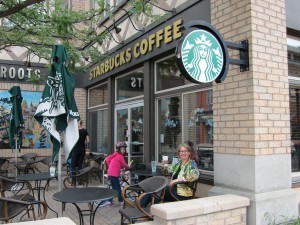
The coffee landscape of Ottawa is changing. Competition is increasing between Canada’s two largest coffee shops: the stereotypically Canadian Tim Horton’s and the chic Seattle chain Starbucks. As Starbucks moves in to the urban cores of Canada’s major cities, there have been many questions as to which coffee is better, or which customers they attract. But another question to ask is which has a better record in terms of health inspections and cleanliness.
For the purposes of this article, the focus will be on locations in Ottawa. Ottawa is split between rural areas with a high concentration of Tim Horton’s restaurants, and urban areas that, while still in favour of Tim Horton’s, are nearly equal with Starbucks locations.

According to their websites, Tim Horton’s and Starbucks have 127 and 46 locations in Ottawa respectively. Out of these, 70% of Tim Horton’s have at one time failed a health inspection between 2009 and 2015, compared to 59% of Starbucks locations. I don’t really think that’s surprising,” says James Kasor, an Ottawa resident and fast food employee. Starbucks has achieved a reputation of a classier coffee establishment.

“Premises are inspected unannounced,” says Donna Casey, Ottawa Public Health Program and Project Management Officer. “Inspection frequency is based on a risk assessment that includes inspection history and the types of foods prepared and sold.” “Currently the presence of any infraction results in a finding of not-in compliance. This means that there are outstanding infractions that require correction.”
Starbucks most commonly failed inspection due to having floors, walls, and ceilings not clean or in good repair. Tim Horton’s, on the other hand, failed most frequently on having equipment, counters, and linen maintained, designed, constructed, installed, and accessible for cleaning. According to another report by CBC Marketplace, several Tim Horton’s inspections revealed issues with general cleanliness. But which offence is more severe?
According to Ottawa Public Health, both of these are non-critical infractions: “They impact the overall sanitary condition of the food establishment, but don’t contribute directly to foodborne illness.” “I mean there’s some degree of a risk no matter where you go out to eat,” says Kasor. “But I’ve definitely had more questionable Tim Horton’s food than Starbucks food.”
“The infractions most commonly committed by the Starbucks and Tim Horton’s locations involve the sanitation and maintenance of a premise. There are a variety of factors which may contribute, one of which may be staff knowledge and behaviour,” says Casey.
So when your next coffee craving hits, keep in mind the pitfalls that often come with choosing the faster option. The extremely high volumes of customers these places receive means employees are under pressure to deliver more food in less time, leaving more room for critical errors.


